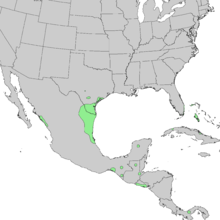Sideroxylon celastrinum
Sideroxylon celastrinum is a species of flowering plant in the family Sapotaceae, that is native to Texas[1] and Florida[2] in the United States south through Central America to northern Venezuela and Colombia in South America. Common names include saffron plum[3] and coma.[4][5] It is a spiny shrub or small tree that reaches a height of 2–9 m (6.6–29.5 ft). The dark green leaves are alternate or fascicled at the nodes and oblanceolate to obovate. Greenish-white flowers are present from May to November and are followed by single-seeded, blue-black drupes.[6]
| Sideroxylon celastrinum | |
|---|---|
.gif) | |
| Scientific classification | |
| Kingdom: | Plantae |
| Clade: | Tracheophytes |
| Clade: | Angiosperms |
| Clade: | Eudicots |
| Clade: | Asterids |
| Order: | Ericales |
| Family: | Sapotaceae |
| Genus: | Sideroxylon |
| Species: | S. celastrinum |
| Binomial name | |
| Sideroxylon celastrinum | |
 | |
| Natural range of Sideroxylon celastrinum | |
| Synonyms | |
|
See text | |
Uses
This plant is known as a first choice deer feed.[4]
Synonyms
- Bumelia angustifolia Nutt.
- Bumelia celastrina Kunth
- Bumelia celastrina var. angustifolia (Nutt.) R.W.Long[7]
- Bumelia spiniflora A.DC.[1]
gollark: If you buy iPhones, you encourage Apple to do silly things. Don't buy iPhones.
gollark: Most trips are *not* that long, and I figure for long ones, if there was more automation and efficiency in the process, you could rent a longer-range car temporarily (in some hypothetical world where this is a common thing).
gollark: Well, then you can use... a non-electric car, for now.
gollark: It's not like you need most cars to be able to satisfy every eventuality.
gollark: As I sort of said, I think having a personal car around all the time which is designed for really long trips and incurs a lot of expense that way is kind of wasteful.
References
- "Sideroxylon celastrinum". Germplasm Resources Information Network (GRIN). Agricultural Research Service (ARS), United States Department of Agriculture (USDA). Retrieved 2009-11-25.
- Wunderlin, R. P.; Hansen, B. F. "Sideroxylon celastrinum". Atlas of Florida Vascular Plants. Plantatlas.org. Retrieved 2009-01-27.
- "Sideroxylon celastrinum". Natural Resources Conservation Service PLANTS Database. USDA. Retrieved 14 November 2015.
- http://www.tpwd.state.tx.us/publications/pwdpubs/media/pwd_bk_w7000_1675_07_11.pdf
- http://woodsroamer.blogspot.com/2011/06/coma-brushland-fruit.html
- Everitt, J. H.; Dale Lynn Drawe; Robert I. Lonard (2002). Trees, Shrubs, and Cacti of South Texas. Texas Tech University Press. p. 190. ISBN 978-0-89672-473-0.
- "Sideroxylon celastrinum". Integrated Taxonomic Information System. Retrieved 2011-10-07.
External links
| Wikimedia Commons has media related to Sideroxylon celastrinum. |
| Wikispecies has information related to Sideroxylon celastrinum |
- "Bumelia celastrina" (PDF). Digital Representations of Tree Species Range Maps from "Atlas of United States Trees" by Elbert L. Little, Jr. (and other publications). United States Geological Survey.
This article is issued from Wikipedia. The text is licensed under Creative Commons - Attribution - Sharealike. Additional terms may apply for the media files.